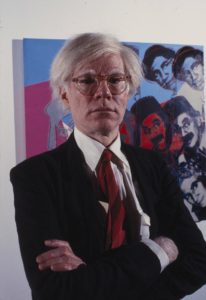Last April, I wrote about an upcoming Supreme Court case concerning Andy Warhol’s Prince portraits. Well, the justices have reached their ruling. In a 7-2 decision, the court has decided against the Andy Warhol Foundation, finding that their licensing of Orange Prince to Condé Nast in 2016 does not qualify as fair use and therefore violates the copyright of Lynn Goldsmith’s original 1981 photograph upon which the Warhol is based.
In 1981, music photographer Lynn Goldsmith photographed the singer Prince Rogers Nelson, who was in the middle of creating his album Controversy. In 1984, when Prince gained popularity after releasing Purple Rain, Vanity Fair ran an article about rock’s newest sensation. They asked Goldsmith if she would license her photograph as an artist reference to create an original illustration. Goldsmith agreed, and Vanity Fair paid her $400. They didn’t tell her the artist they contracted was Andy Warhol. Goldsmith insisted that this licensing would be for one use only. However, Warhol created an entire series of Prince portraits, consisting of thirteen silkscreen prints and three pencil drawings. Goldsmith was not aware of this until 2016, after Prince’s death. Condé Nast, for a special edition commemorating Prince, used Orange Prince on the front cover. The Andy Warhol Foundation had licensed the image for $10,000. After Goldsmith alleged that this licensing violated her photo’s copyright, the AWF sued her.
In this case, the central argument comes down to whether or not the AWF’s licensing of Orange Prince to Condé Nast constitutes fair use, which has four factors. According to section 107 of the United States Code Title 17, the four fair use factors are 1) the purpose and character of the use, 2) the nature of the copyrighted work, 3) the extent to which the copyrighted work was used in the derivative work, and 4) the effect the use has on the potential market value of the original work. The first factor, regarding the purpose and character of the use, is the most important in this instance. Using a copyrighted work qualifies as fair use if the use is considered transformative. Furthermore, if the use of a copyrighted work is for commercial purposes, this often points toward the derivative work not being fair use. Fair use of copyrighted work mostly applies outside of a purely commercial setting, mainly for criticism, news reporting, education, or parody.
Originally, the District Court for the Southern District of New York granted summary judgment in favor of the AWF in 2019, but the Court of Appeals reversed that decision. The AWF relied largely on the first of the four fair use factors concerning the purpose of character of the use. According to the Foundation, taking a photograph, cropping it, and turning it orange is sufficiently transformative since it turns Prince “from a vulnerable, uncomfortable person to an iconic, larger-than-life figure”. The Foundation and the district court held that the other three fair use factors were unimportant.
However, Justice Sonia Sotomayor, writing for the majority, found that the Warhol print and the Goldsmith photograph both serve the same purpose: just as a portrait accompanying articles about Prince. The AWF argued that Warhol added a new expression to the photograph, which they claim made sufficient transformative use. Sotomayor dismisses this: “Orange Prince crops, flattens, traces, and colors the photo but otherwise does not alter it.” Furthermore, Sotomayor writes that the Goldsmith photograph and the Warhol print “share substantially the same commercial purpose.” So, because the print and the photo serve the same purpose, and because the print’s use by the AWF was for commercial licensing, the court decided that AWF’s actions were not fair use and therefore violated Goldsmith’s copyright.
Something important to clarify here is that Goldsmith is not alleging that all of the works in Warhol’s Prince Series are an infringement on her copyright. Only the specific use of Orange Prince on the cover of Condé Nast, as well as the fact that Goldsmith was not credited or compensated for it, is the offending incident. This might have been a different story if the print had been sufficiently transformative. You don’t need to look beyond Warhol’s oeuvre to see examples of the transformative use of copyrighted material. He frequently used copyrighted logos like Campbell’s, Coca-Cola, Brillo, and Muratti. However, the works serve not as advertisements but as commentary on contemporary consumerism.
In her dissent, Justice Elena Kagan wrote that this decision “will impede new art and music and literature. It will thwart the expression of new ideas and the attainment of new knowledge.” While protecting the arts is something that I think any thinking person would agree with, I believe Kagan, as well as Chief Justice Roberts who joined her dissent, may be overreacting. The court did not decide that the Prince Series was copyright infringement, just the one specific instance of the AWF licensing Orange Prince for use in a magazine without crediting Goldsmith. It is unknown whether Andy Warhol Foundation for Visual Arts Inc. v. Goldsmith will set any new precedent or dramatically alter how copyright cases are handled in American courts. With relatively frequent copyright infringement accusations against some artists like Jeff Koons and Richard Prince, that may be the case. But we don’t know that right now. Now is the time to congratulate Goldsmith on gaining the recognition that she did deserve.

